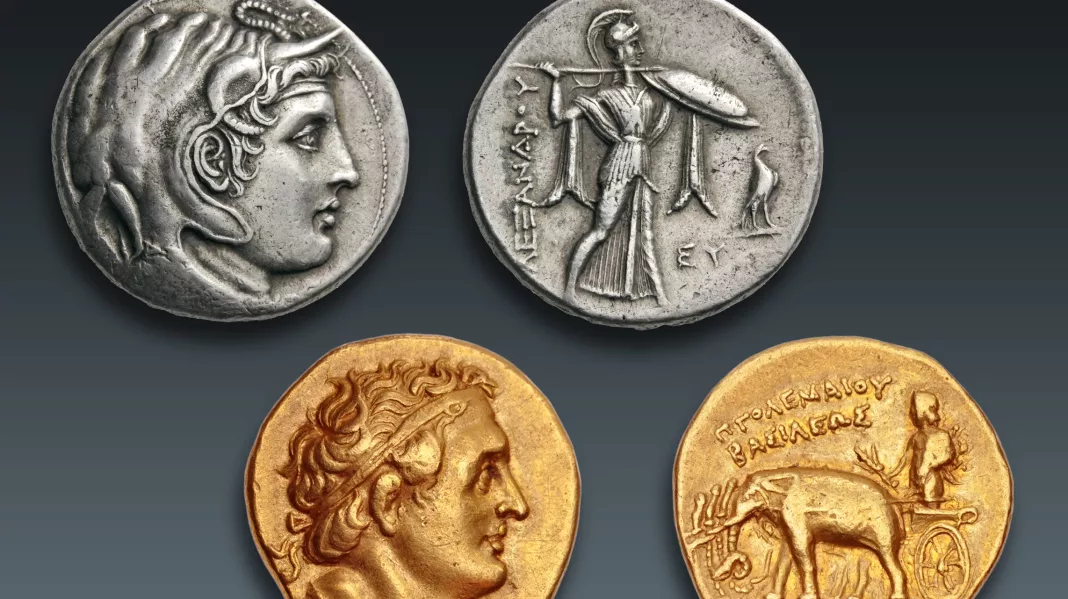There was a shared goal for Hellenistic kings to establish themselves as rulers following the division of Alexander the Great’s empire into three main kingdoms under the Antigonids, the Ptolemies and the Seleucids (323 BC). This resulted in the development of a standardised visual vocabulary of royal ideology represented by statues and coinage.
A newer style of royal portraiture designed to represent the “charismatic, aggressively militaristic ideology of kingship,” won the Successors (Seleucus I Nicator, Ptolemy I Souter and Antigonus the One-Eyed) their kingship in the absence of legitimacy. A common style across the coins reflected beardless, ageless, and jewelled images of Hellenistic kings. In an attempt to associate themselves with the legitimacy expected of a Macedonian king, the Successors adopted this style which evoked images of Alexander who appeared as such in royal portraits, although not originally in coinage.
Statues and coinage maintained a standardised style with defining features exhibited through similar expressions of body language, physiognomy and degrees of divinisation. The use of ‘display poses’ and depictions of fighting figures became a universal language of power adopted by Hellenistic kings to showcase personal dominance. For example, the Terme Ruler (third–second century BC) displays the figure in a relaxed position indicating the fact that he is non-threatened, whilst the tilted pelvis may also reveal security or the absence of fear in the exposure of a man’s most vulnerable area. This common motif depicted ruler figures as confident in their own forms of self-expression and thus in their presentation as kings.
Nudity was also a common theme among royal statues, reminiscent of the gods but adapted to suit them as rulers. This additionally allowed for displays of exaggerated muscularity and athleticism which are further enhanced by a raised grip, all of which are motifs of military and political power. The raised grip itself was a symbolic legitimisation of conquest (‘spear-won land’) initially used by Alexander and later adopted by the Successors as the legal basis for the Hellenistic kingdoms.
Both statues and coinage were heavily influenced by Alexander who popularised costumes and certain attributes to convey royal power and divinity. Hellenistic kings used ram’s or bull’s horns, elephant-scalp headdresses, winged diadems, solar rays and mythological props associated with him. It is common among ruler tetradrachms to see kings presented with royal diadems on their heads, paired with a youthful appearance and full hairline that was evocative of Alexander–asserting his royal authority and legitimacy onto themselves. The Ptolemies favoured divinising iconography which can be seen in the coinage of Ptolemy I and sculptures of Ptolemy II. The former coinage illustrated a goat-skin aegis slung across Ptolemy I which was closely associated with Zeus and identified him with the king of the gods to imply his majesty. The latter portrayed Ptolemy II adorned with an elephant-scalp headdress reminiscent of Alexander’s conquest of Africa, whilst his boots and club displayed the twin divine ancestry of the Ptolemaic dynasty through Heracles and Dionysus.
That is not to say there were no variations in style, as kings adopted different features to emphasise alternate aspects of royal ideology. This idea is demonstrated well by the use of ‘jugate’ portraits under the Ptolemies to convey dynastic continuity. Iconographic depictions of Ptolemy II and Arsinoё II as sibling-gods can be seen in Egyptian coin portraits. The style was a product of Ptolemaic ideology in an Egyptian cultural context and was adopted by other kingdoms, such as the Seleucids, as it was seen as necessary for promoting dynastic continuity and familial similarity.
Even royal female portraiture played an important role. It appears their shared styles with male royal portraits were used as tools to consolidate kingship and dynastic rule. The statuette of Arsinoё II closely resembles that of her brother-husband Ptolemy II in its body language: the body is in a relaxed position to show she does not feel threatened and her arm is raised in a military style which could suggest her influence within the Egyptian government as Ptolemy’s political partner. Alternatively, she is presented as feeling secure under her husband’s rule and mirrors him as an extension of his royal power.
Hellenistic kings had a shared goal to establish themselves as rulers by communicating royal ideology through coins and statues which could be accessed by the public. Royal portraiture was broad but it had definable limits: variations in style formed part of a standardised set of visual elements which conveyed power and status. This form of self-presentation allowed Hellenistic kings to present their personal, charismatic leadership and statesmanship in the absence of legitimacy. As such, their kingship and their family’s dynastic rule were established and maintained, whilst female royal portraiture seems to have acted as an extension of male self-presentation which borrowed from its style.


